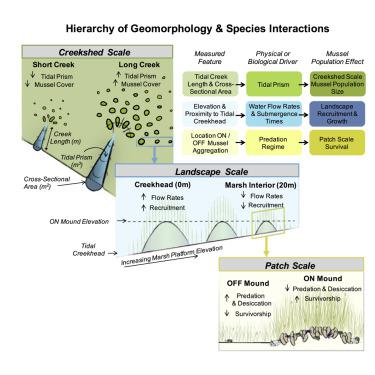当前位置:
X-MOL 学术
›
Curr. Biol.
›
论文详情
Our official English website, www.x-mol.net, welcomes your feedback! (Note: you will need to create a separate account there.)
Geomorphology and Species Interactions Control Facilitation Cascades in a Salt Marsh Ecosystem.
Current Biology ( IF 9.2 ) Pub Date : 2020-03-19 , DOI: 10.1016/j.cub.2020.02.031 Sinéad M Crotty 1 , Christine Angelini 2
Current Biology ( IF 9.2 ) Pub Date : 2020-03-19 , DOI: 10.1016/j.cub.2020.02.031 Sinéad M Crotty 1 , Christine Angelini 2
Affiliation

|
Facilitation cascades are chains of positive interactions that occur as frequently as trophic cascades and are equally important drivers of ecosystem function, where they involve the overlap of primary and secondary, or dependent, habitat-forming foundation species [1]. Although it is well recognized that the size and configuration of secondary foundation species' patches are critical features modulating the ecological effects of facilitation cascades [2], the mechanisms governing their spatial distribution are often challenging to discern given that they operate across multiple spatial and temporal scales [1, 3]. We therefore combined regional surveys of southeastern US salt marsh geomorphology and invertebrate communities with a predator exclusion experiment to elucidate the drivers, both geomorphic and biotic, controlling the establishment, persistence, and ecosystem functioning impacts of a regionally abundant facilitation cascade involving habitat-forming marsh cordgrass and aggregations of ribbed mussels. We discovered a hierarchy of physical and biological factors predictably controlling the strength and self-organization of this facilitation cascade across creekshed, landscape, and patch scales. These results significantly enhance our capacity to spatially predict coastal ecosystem function across scales based on easily identifiable metrics of geomorphology that are mechanistically linked to ecological processes. Replication of this approach across vegetated coastal ecosystems has the potential to support management efforts by elucidating the multi-scale linkages between geomorphology and ecology that, in turn, define spatially explicit patterns in community assembly and ecosystem functioning.
中文翻译:

盐沼生态系统中的地貌和物种相互作用控制促进级联反应。
促进级联是与营养级联反应一样频繁发生的积极相互作用的链,是生态系统功能的同等重要的驱动力,它们涉及主要和次要或依赖的,形成栖息地的基础物种的重叠[1]。尽管众所周知,次生基础物种斑块的大小和构型是调节促进级联生态效应的关键特征[2],但鉴于它们在多个时空范围内运作,控制其空间分布的机制通常难以辨别。标度[1,3]。因此,我们将对美国东南部盐沼地貌和无脊椎动物群落的区域调查与掠食者排斥实验结合起来,以阐明地貌和生物的驱动因素,持久性以及对生态系统功能的影响,这是一个区域丰富的促进级联反应的过程,其中包括形成栖息地的沼泽象草和罗纹贻贝的聚集体。我们发现了物理和生物学因素的层次结构,可预测地控制这种促成小溪,景观和斑块尺度的级联的强度和自组织。这些结果大大增强了我们根据容易识别的与生态过程相关的地貌指标来跨尺度预测沿海生态系统功能的能力。通过阐明地貌学与生态学之间的多尺度联系,进而在植被繁茂的沿海生态系统中复制这种方法,有可能支持管理工作。
更新日期:2020-04-20
中文翻译:

盐沼生态系统中的地貌和物种相互作用控制促进级联反应。
促进级联是与营养级联反应一样频繁发生的积极相互作用的链,是生态系统功能的同等重要的驱动力,它们涉及主要和次要或依赖的,形成栖息地的基础物种的重叠[1]。尽管众所周知,次生基础物种斑块的大小和构型是调节促进级联生态效应的关键特征[2],但鉴于它们在多个时空范围内运作,控制其空间分布的机制通常难以辨别。标度[1,3]。因此,我们将对美国东南部盐沼地貌和无脊椎动物群落的区域调查与掠食者排斥实验结合起来,以阐明地貌和生物的驱动因素,持久性以及对生态系统功能的影响,这是一个区域丰富的促进级联反应的过程,其中包括形成栖息地的沼泽象草和罗纹贻贝的聚集体。我们发现了物理和生物学因素的层次结构,可预测地控制这种促成小溪,景观和斑块尺度的级联的强度和自组织。这些结果大大增强了我们根据容易识别的与生态过程相关的地貌指标来跨尺度预测沿海生态系统功能的能力。通过阐明地貌学与生态学之间的多尺度联系,进而在植被繁茂的沿海生态系统中复制这种方法,有可能支持管理工作。


























 京公网安备 11010802027423号
京公网安备 11010802027423号